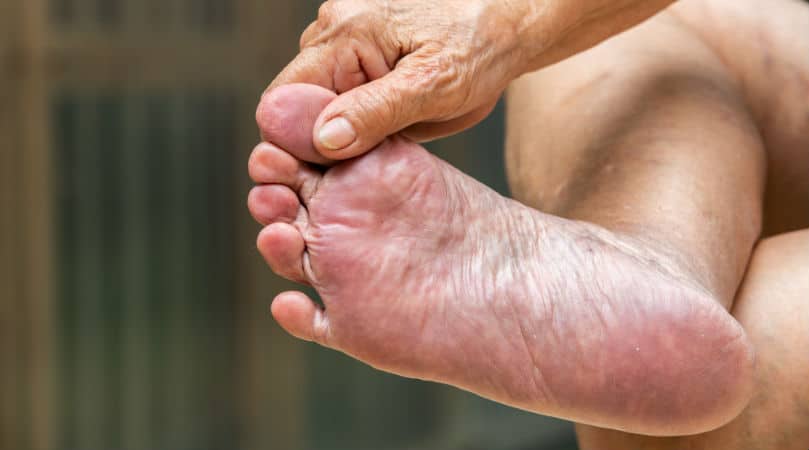Understanding Diabetic Foot Care
If you are someone who has been diagnosed with diabetes, then taking care of your feet should be top priority on your daily to-do list. Without prevention, chances of amputation or developing a serious condition like an ulcer, can drastically increase.
In some cases, diabetes can cause nerve damage, taking away feeling in your feet. Diabetes may also reduce blood flow to your feet which, in turn, makes it hard to resist infection and heal any potential injuries. Because of this, diabetes can be extremely dangerous – you may not be able to identify threating objects upon touching them with your feet, and if this results in even a minor sore or cut, the injury may become infected or not heal. And, that is the beginning of the snowball effect.
Therefore, understanding diabetes and how to best live with it is vital for your health. Becoming familiar with this condition should be your first step. So, let’s get it done!
Understanding Diabetes
Essentially, diabetes means that you have high blood sugar levels and this condition may have a negative impact on the nervous system’s cells. These damaged nerves can result in diabetic neuropathy, or the loss of feeling in your feet, and even hands.
According to research, diabetic neuropathy is experienced by at least 70% of people diagnosed with diabetes and is the primary cause for harmful infections – and if you lack feeling in your feet, noticing cuts or sores can be difficult. As these pains and irritations continue to go unnoticed, chances are that they will become infected, and when untreated, infections can lead to gangrene which may require amputation.
It is worth noting that diabetic neuropathy also causes dry skin – the disabled nerves on the feet are unable to process brain triggers which normally signal the feet to produce sweat. If your feet are constantly dry, chances are they may crack, welcoming bacteria to enter the body.
Another symptom of diabetic neuropathy is that it may cause changes to the shape of your feet – shoes which were once comfortable to walk in can then cause calluses and blisters. Again, welcoming germs and bacteria into the body.
You may be asking yourself, “So, what should I do to prevent such scary symptoms?”. Well, here are some tips to help you stride on with confidence!
Taking Care of Your Feet
Should you soak your feet? No. Should you lotion between your toes? Absolutely not.
When you have diabetes, taking care of your feet can be tricky. Why should you not soak your feet? Doing so can cause your already-vulnerable skin to become too dry or too soft. Why should you not apply lotion between your toes? This may encourage fungus growth.
Then what is there left to do?
No need to panic, there are plenty of other options when it comes to caring for your feet. So, listen up:
- Check your feet daily. Look for any cracks, sores, or wounds. If you are unable to see the bottom of your feet, place a mirror on the floor or ask a friend/relative to inspect your feet for any changes in color, sores, or dry, cracked skin.
- Use diabetic-friendly footwear. Try opting for shoes that have deeper toe boxes and good coverage on both the top and bottom of the feet. Refrain from wearing shoes as well as socks with seams on the inside. And, always wear materials which are breathable, like cotton.
- Never go barefoot. You probably already know that wearing shoes outside is a must when you have diabetes. However, you should always wear shoes whenever you are home, too. It’s better to be safe than sorry! Try wearing supportive slippers if you are looking for something more comfortable to wear around the house.
- Keep your feet dry. After taking showers, always dry your feet thoroughly – and remember to get between your toes. Whenever your socks get sweaty or wet, remove them immediately. If your skin is dry, you may apply lotion – but never in excess or between your toes.
- Stabilize your feet. Wearing orthotics is a great investment even for those who don’t have problematic feet. Orthotics provide comfort as well as protection, which can minimize the potential for blisters, calluses and other types of sores.
- Check your shoes for foreign objects. Sometimes things can get into places that they don’t belong. So, you should check the inside of your shoes before putting them on your feet. Simply turn the shoe upside-down and give it a little shake.
- Go easy on your feet. Of course, exercising is beneficial whether you have diabetes or not. However, when you have diabetes, you should be mindful about the intensity of exercises. Avoid a lot of bouncing and jumping. Instead, opt for activities which tend to cause less pressure on your feet like walking or swimming.
- Keep an eye on your blood sugar levels. The higher those levels are, the more prone to infection and non-healing wounds you will be. If you control your blood sugar, your feet will be healthier in the long-term. Check with your doctor for the best ways to keep those levels under control.
- Quit smoking. Cigarette smoking constricts blood vessels, causing poor blood circulation and emphasizing diabetic symptoms.
- See a podiatrist regularly. Especially whenever you develop any calluses, blisters or sores. You may think that you can just buy an over-the-counter medication to solve the issue, but even those may cause irritation. It is best to seek professional help as well as perform regular check-ups.
Following these steps will significantly reduce your chances of developing debilitating wounds and infections. But if you need any more assistance, we are also here to help guide you in the right direction.
Need More Information?
If you have any doubts or concerns about your foot health, would like to come in for a checkup with one of our podiatrists, or would simply like to add one of our doctors to your team of health care experts, get in touch with our office, Community Foot Clinic of McPherson, online or by phone at (630) 241-3313.
McPherson Office
316 W. 4th Street
McPherson, KS 67460
P: (620) 241-3313
F: (620) 241-6967
© Community Foot Clinic of McPherson. All Rights Reserved.
Privacy Policy | Terms & Conditions
Web Design by CP Solutions
Marketed by VMD Services


